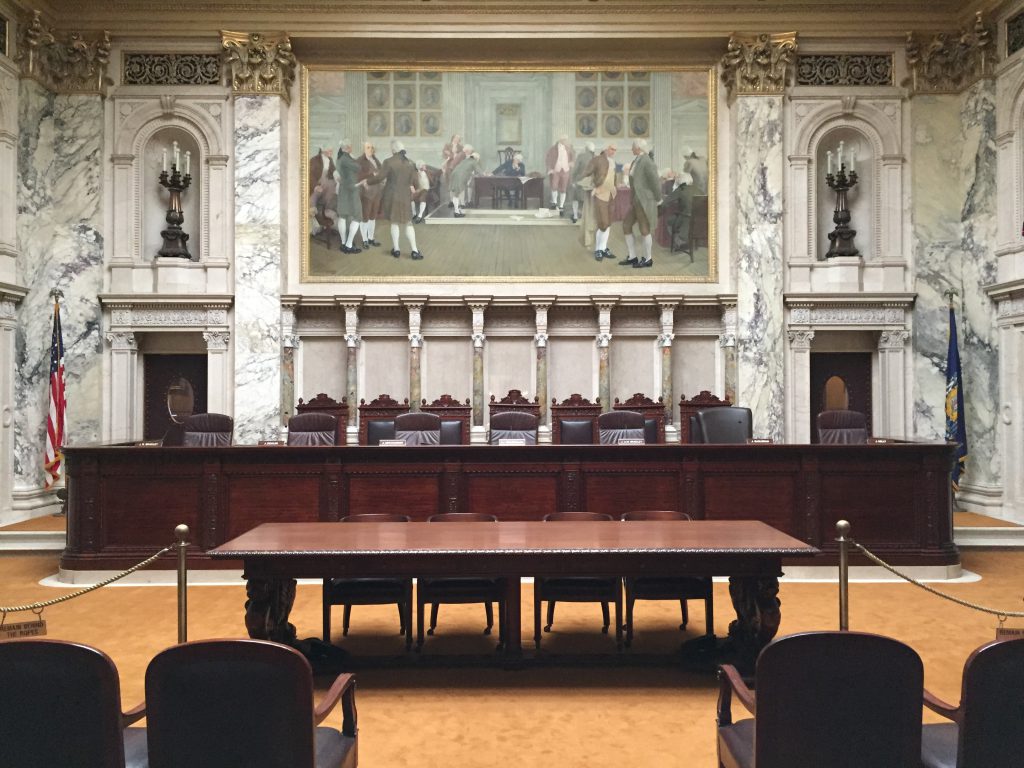The Wisconsin Supreme Court Starts Its Review of Gerrymandering Case
And conservative justices are already dissenting.
Two lawsuits were brought to the Wisconsin Supreme Court challenging the current Wisconsin state senate and assembly plans which heavily favor Republican over Democratic voters. The two were labeled Rebecca Clarke v. Wisconsin Elections Commission (Clarke v. WEC) and Stephen Joseph Wright v. Wisconsin Elections Commission (Wright v. WEC).
On Oct. 6, the court issued an order rejecting Wright while accepting Clarke for further briefing. The court did not explain its rationale for accepting the first case and rejecting the second. However, it may have decided that dealing with only one would make life simpler and that Clarke was submitted first.
But in accepting Clarke the court declined to consider the first three of the petitioners’ issues. “Although these issues raise important and unresolved questions of statewide significance, the need for extensive fact-finding (if not a full-scale trial) counsels against addressing them at this time.”
Here are the rejected issues:
- Whether the redistricting plans are “extreme partisan gerrymanders that violate Article I, Section 1 of the Wisconsin Constitution’s guarantee of equal protection under law …”
- Whether the plans retaliate against voters based on their viewpoint and exercise of free speech and abridge the ability of voters with disfavored political views to associate with others to advance their political beliefs in violation of Article I, Sections 3 and 4 of the Wisconsin Constitution …
- Whether the plans fail to adhere to justice, moderation, temperance, frugality, and virtue, … and fundamental principles” in violation of Article I, Section 22 of the Wisconsin constitution.
The court did not address the question of what fact-finding would be needed. However, the apparent need for fact-finding would suggest that a separate lawsuit at the district court level focused at these three issues might be productive.
The court accepted the petitioners’ issues four and five, making them issues one and two. It added two additional issues related to how a decision might be implemented, to arrive at four issues to be considered:
- “Whether the plans violate the requirement of Article IV, Sections 4 and 5 of the Wisconsin Constitution that legislators be elected from districts consisting of ‘contiguous territory.’”
The Wisconsin Constitution has long required that state senate and assembly districts be “contiguous.” What does the word mean? One dictionary defines “contiguous” as “sharing a common border; touching.” Another says that rather than “’being in close proximity,’ contiguous implies having contact on all or most of one side.”
Since at least the 1970s, many Wisconsin redistricting laws have language redefining “contiguous” to include noncontiguous islands, “territory belonging to a city, town or village but not contiguous to the main part thereof.” Such islands are “considered a contiguous part of its municipality.” Lacking a constitutional amendment, this would seem to contradict the clear language of the state’s constitution. Contrast this with the constitution’s language on school board elections: “Ensure that, to the extent practicable, the territory within each election district … is contiguous.”
- “Whether the maps mandated by the Court violate the separation-of-powers principle inherent in the constitution’s division of legislative, executive, and judicial power by usurping the Governor’s core constitutional power to veto legislation and the Legislature’s core constitutional power to override such a veto.”
The former court majority adopted the same plan that the governor vetoed. The legislature was unable to override his veto. In effect, the court majority gave the legislature the answer it could not get by itself.
- “If the court rules that maps violate the Wisconsin Constitution for either or both of these reasons and the legislature and the governor then fail to adopt state legislative maps that comply with the Wisconsin Constitution, what standards should guide the court in imposing a remedy for the constitutional violation(s)?”
- “What fact-finding, if any, will be required if the court determines there is a constitutional violation based on the contiguity clauses and/or the separation-of-powers doctrine and the court is required to craft a remedy for the violation? If fact-finding will be required, what process should be used to resolve questions of fact?”
The court also included a briefing schedule, leading to oral arguments on Nov. 21.
More than 30 pages of dissents were submitted by justices Annette Ziegler, Rebecca Grassl Bradley and Brian Hagedorn objecting to the court majority’s decision. Each of the three justices wrote their own dissents. With two exceptions, each of the three in turn endorsed the other two dissents. The exceptions were justices Bradley and Hagedorn who did not endorse each other’s dissent.
The decision by the previous court to select a “least change” district plan had obvious advantages for one of the two parties. The previous district maps were carefully crafted to disadvantage Democratic candidates. The least change strategy guaranteed that this advantage would continue at least for the next 10 years.
For evidence, one need only look at this year’s Supreme Court election. If the candidate who won 55.5% of the popular statewide vote still lost the majority of assembly districts it is hard to argue that partisanship played no role in the design of the maps.
The ferocity of the reaction to the court’s decision to reconsider the gerrymandered maps suggest that the three dissenters view their role as a partisan one, as a protector of a Republican interests. They have clearly made up their minds to reject any decision that would advance Wisconsin democracies.
I plan to next look at that reaction in more detail.
UPDATE: A reference in one paragraph to fact checking has been updated to fact finding.
If you think stories like this are important, become a member of Urban Milwaukee and help support real, independent journalism. Plus you get some cool added benefits.
Data Wonk
-
Why Absentee Ballot Drop Boxes Are Now Legal
 Jul 17th, 2024 by Bruce Thompson
Jul 17th, 2024 by Bruce Thompson
-
The Imperial Legislature Is Shot Down
 Jul 10th, 2024 by Bruce Thompson
Jul 10th, 2024 by Bruce Thompson
-
Counting the Lies By Trump
 Jul 3rd, 2024 by Bruce Thompson
Jul 3rd, 2024 by Bruce Thompson





















In 2010, redistricting moved 1 million people into new districts. “Least change” was found irrelevant. In 2020, “least change” became important to the dissenters. They have never
explained why something so important went from irrelevant to most important. The law did not change and yet their positions did. Do they have any actual positions or do they just do whatever they want? If justices have no fixed ideas on the law, what does that say about the dissenters?